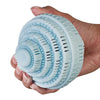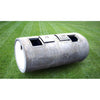Laundry: A Quantum Mechanical Approach by: Brian J. Reardon
It has been argued that the act of doing laundry followed the discovery of clothing by only a few weeks. While this fact has been regarded to be fantastically trivial, one can not ignore the enigmas that the act of doing laundry has created. This is especially true in the age of high speed washers and dryers. In the early days, the disappearance of articles of clothing could simply be accounted for by saying that the sock was lost in the river. Unfortunately, such excuses can no longer be used today. The availability of high speed automated washers and dryers has provided a number of fundamental questions that can not be answered using the classical laundry theory (i.e.: the river washed the sock away). Such questions include:
Where, exactly does lint come from and why does the quantity of lint change from load to load?
*If the washing machine is a closed system, how can socks disappear?
*When using public washing machines and dryers, why is it that every once in a while you will find someone else’s socks in your load even when you checked the washer/dryer ahead of time?
The inability to answer these questions using the classical theory of laundry resulted in the development of new theories. This paper is a simple introduction to the quantum theory of laundry. As a result, it only deals with the simplest example in which a sock is analyzed in either a washer or a dryer. The mathematics involved in the analysis of a sock in both a washer and dryer and in transition between the two is left for more advanced laundry courses.
The first modern attempt to explain the fundamental questions of laundry involved the decay theory. The decay theory states that the quantity of socks in a load can be expressed as a decreasing exponential function of time which is analogous to radioactive decay (see equation 1).
Nt =N0*exp(-pt) (1)
The decay theory easily explains the origin of lint and why new socks tend to release more lint than old socks. However, according to this theory, socks should never completely disappear, or, more importantly, reappear. This clearly contradicts everyday experience.
The Quantum Theory of Laundry
The quantum theory of laundry (QTL), however, can explain the fundamental questions of laundry. The QTL is base on three intuitive assumptions.
The sock never leaves the enclosed system of the washer or dryer.
The sock is confined to the total washer system it is not confined to the main washing compartment. It may be in the main washing compartment, in the lint trap , or anywhere in between. The sock can be expressed mathematically as a wave function of position and time (Y(x,t)).
These assumptions can be mathematically manipulated to provide a number of functions and conditions which are in close correspondence to quantum theory.
The first such condition is that the error is observing the position of a sock in a system multiplied by the error in measuring the momentum of the sock as it travels in the system is a constant. This relation is commonly referred to in quantum mechanic circles as the Heisenburg Uncertainty Principle(see equation 2). The implication of this relation is quite profound. If one disturbs the washer by looking in it or if one ends its cycle, the act of observing the sock in the main compartment will increase the error in knowing exactly how fast the sock is moving within the system as a whole. This means that the computerized tracking system in the machine that tries to maintain a statistical analysis of where every sock might be may accidentally misplace a sock somewhere in the washing system.
The second result of the basic assumptions of the QTL is that the sock must always be somewhere in the washing system. This implies that the probability of finding the sock somewhere within the system at any time must always equal unity, or, the integral of the sock wave function squared must equal 1 (see equation 3).
The decay theory easily explains the origin of lint and why new socks tend to release more lint than old socks. However, according to this theory, socks should never completely disappear, or, more importantly, reappear. This clearly contradicts everyday experience. The Quantum Theory of LaundryThe quantum theory of laundry (QTL), however, can explain the fundamental questions of laundry. The QTL is base on three intuitive assumptions. The sock never leaves the enclosed system of the washer or dryer. While the sock is confined to the total washer system it is not confined to the main washing compartment. It may be in the main washing compartment, in the lint trap , or anywhere in between. The sock can be expressed mathematically as a wave function of position and time (Y(x,t)). These assumptions can be mathematically manipulated to provide a number of functions and conditions which are in close correspondence to quantum theory. The first such condition is that the error is observing the position of a sock in a system multiplied by the error in measuring the momentum of the sock as it travels in the system is a constant. This relation is commonly referred to in quantum mechanic circles as the Heisenburg Uncertainty Principle(see equation 2). The implication of this relation is quite profound. If one disturbs the washer by looking in it or if one ends its cycle, the act of observing the sock in the main compartment will increase the error in knowing exactly how fast the sock is moving within the system as a whole. This means that the computerized tracking system in the machine that tries to maintain a statistical analysis of where every sock might be may accidentally misplace a sock somewhere in the washing system. The second result of the basic assumptions of the QTL is that the sock must always be somewhere in the washing system. This implies that the probability of finding the sock somewhere within the system at any time must always equal unity, or, the integral of the sock wave function squared must equal 1 (see equation 3).
P(x) = òY*Ydx = òïY2êdx = 1 (3)
Using these assumptions, a general form of the wave function for the sock in the washer can be inferred. This function is identical to the standard solution to the schroedinger Wave Equation ( SWE ) and can be expressed as two partial derivatives of time and space.
-h2¶2Y +U(x) = ih¶2Y (4)
8mp2¶x2 2p¶t2 8mx2t
The sock wave functions that satisfy the SWE can take three forms that represent the three different possible places the sock can reside within the washing system. The entire system can be pictured as an infinite potential energy well that contains a finite energy barrier. The main washing compartment is represented as a potential well(5), the washing system is represented by the potential barrier(6), and the lint trap is represented by another, but narrower, potential well(7).
Y1(x,t) = Asin(kx-wt) + Bcos(kx-wt) (5)
Y2(x,t) = E exp(-Fx-ut) (6)
Y3(x,t) = Csin(kx-wt) + Dcos(kx-wt) (7)
Where, the constants A, B, C, D, E, and F, are material properties of the sock and washer system and w, k, and u are cyclic properties of the postion of the sock within the washer.
The QTL explains the fundamental of problems of laundry in a very direct manner. The origin of lint can now be defined as the sum of probabilities that a sock traveled or tunneled through the washing system into the lint trap. The sock tunneling phenomenon is analogous to the electron tunneling phenomena in quantum mechanics. The occasional presence of large quantities of lint is easily explained by the real likelihood that entire socks can spontaneously take on the wave function of the lint trap.
The QTL also explains that socks never actually disappear. Quite simply, at the time of disturbance or stopping of the machine they have a wave function that puts them temporarily in the washing system or completely converts them to lint.
Furthermore, if a machine is disturbed during a subsequent washing cycle there is a finite probability that a sock lost in previous cycles may reappear in the main washing compartment. This explains the appearance of other people’s sock in your wash.
Lastly, the disappearance of entire loads can be explained by the existence of the finite probability that all of the socks in the main compartment have taken on the wave function of the lint trap and subsequently turned to lint. This further implies that instead of accusing someone of stealing your socks, running the machine while empty for long periods of time will increase the chances of retrieval of most of the socks.
While the current implications of the QTL seem extraordinary, the far reaching implications may redefine laundromat etiquette for centuries to come.
*The more often you disturb the system the greater the chance of losing a sock and the greater the chance of retrieving a previously lost sock from someone else’s load.
*Furthermore, there is always a probability that an entire load of socks can be lost since the act of disturbing the machine is always a part of doing laundry. *Thirdly, throwing away lint makes the retrieval of lost socks more difficult. So in all fairness to everyone who has ever used the machine, the lint should never be removed.
*Fourthly, and for the individual, most importantly, when at a laundromat one should always insist on using the same washer and dryer to increase your chances of retrieving previously lost socks.
*Lastly, and most importantly, washing machine repair persons will now be required to have extensive backgrounds in quantum mechanics.













